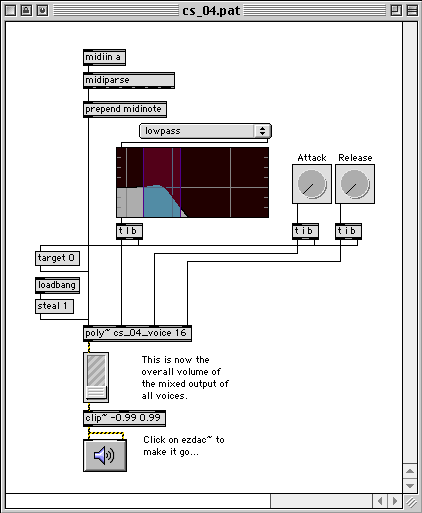


Bottom: a Max patcher hosting the gen~ for testing and development, alongside Oopsy for automatic firmware generation and upload to hardware, here configured for the Daisy Patch to run at 48kHz sampling rate, 48-sample block size, boosted CPU frequency and faster math functions. Top-left: a gen~ patcher, here implementing a frequency modulation algorithm, with several knobs defined by param objects. The Oopsy workflow focuses on lightweight design, with minimal input required to get an algorithm onto hardware, coupled with a targeted firmware generation that optimizes for CPU usage, memory footprint, and program size.Īn example of the Oopsy workflow. This article describes a new addition to these domains, focused on streamlining algorithm development from the established desktop environment of Max/gen~ to the capabilities of Daisy hardware, a low cost and small format self-contained solution for embedded GPIO and digital signal processing which was the result of a successful Kickstarter campaign in 2020. Here, affordable flashable hardware offers an intermediate balance between tactility and modal flexibility. It has also contributed to a growing community of musicians moving away from desktop/laptop computer workspaces toward hardware and modular synthesis, sometimes characterized by terms “out of the box” and “DAWless” (i.e., without a digital audio workstation).
Max synthesizer tutorial software#
Making microcontrollers such as Arduino and Teensy more accessible to musicians and luthiers has had a significant impact in the development of new music controllers, instruments, and modular synthesis modules, and the corpus of NIME research includes numerous software systems to streamline embedded development from more flexible and comfortable desktop environments. The increasing power of available microcontrollers and single-board computers allows the development of new digital musical instruments (DMIs) that can combine the benefits of both general-purpose analogue sensors and controls along with audio-rate digital signal processing. Applied computing → Sound and music computing Introduction.
Max synthesizer tutorial code#
Author KeywordsĮmbedded audio, DIY Hardware, Code Generation, Modular Synthesis, Low Latency, Max/gen~, Electro-smith Daisy CCS Concepts The paper locates this work in the context of related software/hardware workflows, and provides detail of its contributions in design, implementation, and use. Specifically, algorithm design takes place in the flexible context of gen~ in Max, and Oopsy automatically and fluently translates this and uploads it onto the open-ended Daisy embedded hardware. This pipeline gives digital instrument designers the development flexibility of established software with the deployment benefits of working on hardware. This paper describes Oopsy, which provides a streamlined process for editing digital signal processing algorithms for precise and sample accurate sound generation, transformation and modulation, and placing them in the context of embedded hardware and modular synthesizers.


 0 kommentar(er)
0 kommentar(er)
